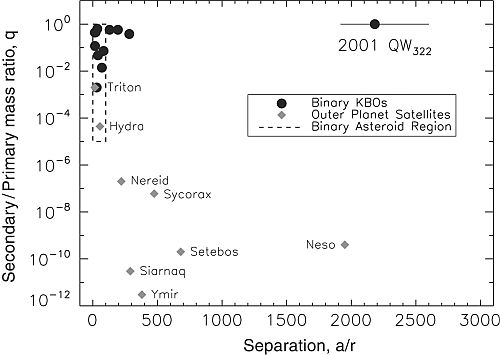The Extreme Kuiper Belt Binary 2001 QW322
WHT+PFIP
A combination of survey strategies and adaptive optics technologies has led to a surge in the discovery rate of binary minor planets. At present, there are more than 100 known binaries, nearly half of which are
Kuiper Belt objects (KBOs). Measurements of the frequency of binary objects and their sizes and orbital configurations constrain their formation and evolution mechanisms, theories of planetesimal
accretion and disruption, and the collisional history of the Kuiper Belt.
A team of astronomers reported the mutual-orbit determination of the large-separation Kuiper Belt binary, 2001 QW322. The two components of this
KBO have identical magnitudes of mR=24.0 approximately, implying essentially equel sizes. 2001 QW322 is exceptional because the measured separation of ~4 arcseconds at its distance of 43 AU
corresponds to a sky-projected physical separation of 125,000 km, about one-third of the distance from Earth to the Moon, far larger
than any other small-body bianry.
 |
Secondary-to-primary mass ratio versus average separation (in units of the primary's radius). The dashed box represents the known binary asteroids, all on the left side of the plot (the largest separation barely exceeds 100). Also shown are the most-extreme,
outer-planet irregular satellites and several other binary KBOs. 2001 QW322 clearly stands out in the top-right corner of this diagram as the widest-orbit, near-equal-mass binary of the solar system.(extracted from Petit et al., 2008,
Science, 322, 432). [ JPEG ].
|
The large separation implies a mutual-orbit period of at least several years. Six years of tracking with the use of 4- to 8-m class telescopes, among them the William Herschel Telescope, resolved that 2001 QW322, an object in the main classical Kuiper Belt, has a low-eccentricity mutual orbit with a separation of 105,000 to 135,000 km,
greater than any other known minor-planet binary. The separation is so large that this nearly equal-mass binary should be incredibly fragile to dynamical disruption, and its continued existence in the middle
of the main Kuiper-Belt puts strong constraints on the history of the Belt. Either 2001 QW322 was created with its current mutual orbit early in the history of the solar system,
in which case it is one of the few survivors of a population at least 50 to 100 times larger, or this is a transitory object, evolving because of perturbation from interactions with smaller KBOs, from
a population of more tightly bound binaries.
More information:
-
J.-M. Petit, J. J. Kavelaars, B. J. Gladman, J. L. Margot, P. D. Nicholson, R. L. Jones, J. Wm. Parker, M. L. N. Ashby, A. Campo Bagatin, P. Benavidez, J. Coffey, P. Rousselot, O. Mousis, P. A. Taylor, 2008,
"The Extreme Kuiper Belt Binary 2001 QW322", Science, 322, 432.
|



